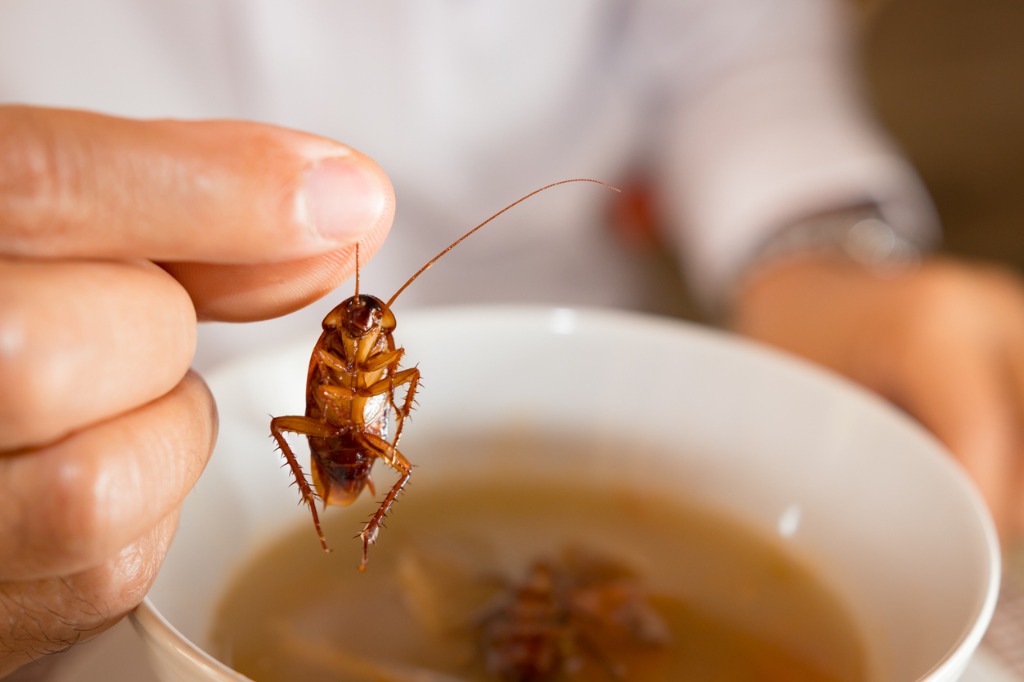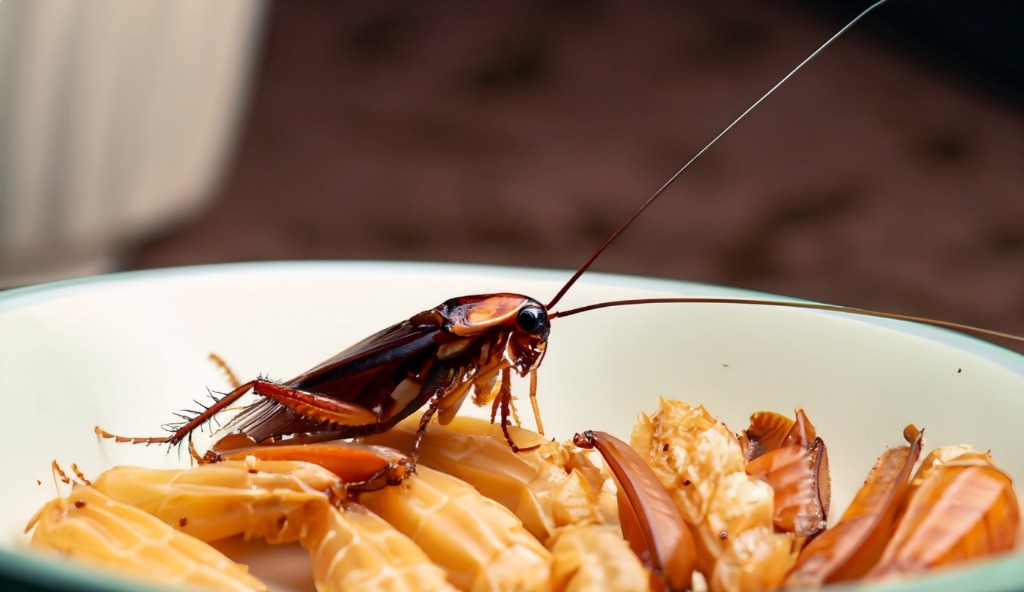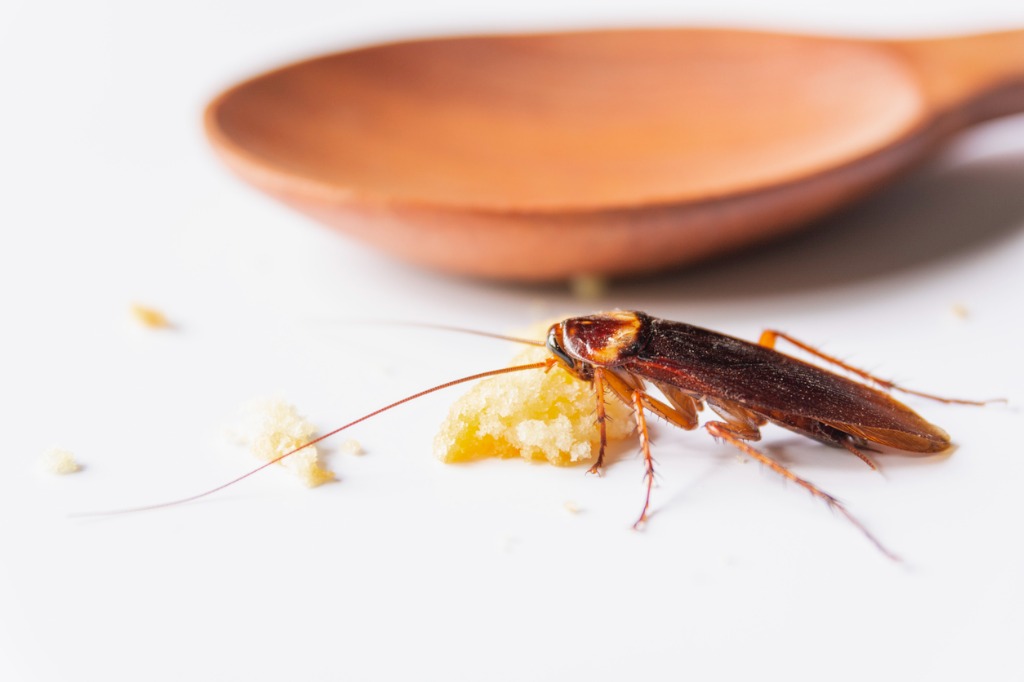Brace yourself for a shocking revelation: your cozy home might be harboring more than just your family and beloved pets. Hidden within the walls and under the floorboards lies an army of cockroaches, silently carrying a secret burden – diseases that could put your health at risk. The unsuspecting insects are not only masters of survival but also skilled transmitters of dangerous ailments such as E.coli and Poliovirus. So it’s time to pull back the veil on these hidden dangers and arm yourself with knowledge on how to keep these disease-ridden invaders at bay.
Key takeaways
- Cockroaches can transmit diseases like salmonellosis, typhoid fever, and cholera.
- Prevention is crucial: maintain cleanliness, seal entry points, and store food securely.
- After treatment, continue sanitation practices to prevent reinfestation.
- Natural methods include diatomaceous earth, traps, and essential oils.
- Complete cockroach elimination is challenging but achievable with persistent efforts.
- Recognize signs of infestation and practice good personal hygiene for protection.
What diseases can be transmitted by cockroaches?
Cockroaches are known to carry and transmit a variety of diseases and pathogens. These include bacteria like Salmonella and E. coli, which can lead to food poisoning and gastrointestinal issues. They can also harbor viruses, such as the poliovirus and hepatitis virus, and parasites like the protozoa that cause dysentery. Furthermore, cockroach allergens can trigger asthma and allergic reactions in some individuals.
How do cockroaches transmit diseases?

A2: Cockroaches can transmit diseases through direct and indirect contact. They often pick up pathogens and contaminants on their legs and bodies as they move through unsanitary environments like sewage or garbage. These pathogens can be transferred to food, surfaces, or utensils when cockroaches come into contact with them, leading to contamination. Additionally, cockroach feces and shed skin can contain allergens that become airborne and are inhaled by humans, causing respiratory problems.
Common Cockroach Species
Identification and Habitat
Common cockroach species share certain identifying characteristics, such as flattened bodies, long antennae, and typically brown or reddish-brown coloration. Among these pests, several stand out as frequent invaders of human environments.
The German Cockroach (Blattella germanica), for instance, is small and light brown to tan, featuring parallel stripes on its pronotum. It thrives in warm, humid locations, often seeking refuge in cracks and crevices in areas like kitchens and bathrooms. Meanwhile, the American Cockroach (Periplaneta americana) is larger and sports a reddish-brown coloration with a distinctive yellowish pattern on its thorax. It prefers damp and dark spaces, such as basements, sewers, and drains.
The Oriental Cockroach (Blatta orientalis) is characterized by its dark brown to black color and a shiny appearance, commonly found in high-moisture environments like basements and crawlspaces. Lastly, the Brown-banded Cockroach (Supella longipalpa) is smaller than the German variety, has light brown coloration, and is distinguished by two prominent bands across its wings. It tends to inhabit warm and dry places, such as bedrooms and closets.
Distribution and prevalence
The distribution and prevalence of common cockroach species are influenced by their adaptability and habitat preferences. German Cockroaches are widely distributed globally and are notorious for infesting human habitation, commonly found in homes, restaurants, and commercial kitchens. American Cockroaches are prevalent in North America but can also be encountered in regions with warm and humid climates, often dwelling in sewers and underground utilities.
Oriental Cockroaches are frequently observed in temperate regions, particularly in the United States and Europe, where they favor damp and cool areas like basements and sewers. Brown-banded Cockroaches have a wider distribution in tropical and subtropical regions and, while less common than German cockroaches, can still pose issues, particularly in warmer climates. Understanding the specific characteristics and preferences of these common cockroach species is crucial for effective pest control and management strategies.
Diseases Transmitted by Cockroaches

Overview of diseases
Cockroaches are notorious disease vectors as they can carry various pathogens and spread diseases to humans. These insects often infest unsanitary environments, and their presence in homes or food preparation areas can pose significant health risks.
Specific diseases and pathogens
- Salmonellosis: Cockroaches can transmit Salmonella bacteria, which cause food poisoning. They pick up these pathogens by crawling on contaminated surfaces or consuming contaminated food and then spread them through their droppings and body parts.
- Dysentery: The pathogens responsible for dysentery, such as Shigella and E. coli, can be carried by cockroaches. These bacteria can cause severe gastrointestinal illnesses when ingested after contact with contaminated surfaces or food.
- Typhoid Fever: Cockroaches can harbor Salmonella Typhi, the bacterium that causes typhoid fever. If they come into contact with food or water supplies, they can transmit this serious disease.
- Cholera: Cholera is caused by the Vibrio cholerae bacterium, which can be spread by cockroaches that come into contact with contaminated water sources and subsequently contaminate food or utensils.
- Allergies and Asthma: Cockroach allergens, found in their saliva, feces, and shed skin, can trigger allergies and exacerbate asthma symptoms in some individuals.
- E. coli Infections: Cockroaches can carry and transmit various strains of Escherichia coli (E. coli), which can lead to infections when contaminated surfaces or food are ingested or touched.
How diseases are transmitted
Cockroaches transmit diseases through several mechanisms:
- Contamination of Food and Surfaces: Cockroaches move through unsanitary areas, such as sewers and garbage, picking up pathogens on their legs and bodies. When they crawl on food, utensils, or food preparation surfaces, they can deposit these pathogens, leading to contamination.
- Fecal Matter and Saliva: Cockroaches produce feces and saliva that may contain pathogens they have ingested. When they defecate or regurgitate, they can spread these microorganisms onto surfaces, food, or utensils.
- Direct Contact: People can become infected when they come into direct contact with cockroaches. This can happen when a cockroach crawls on a person, potentially transferring pathogens to the skin or clothing.
- Airborne Allergens: While not a disease transmission method per se, cockroach allergens can become airborne and lead to allergies and asthma in susceptible individuals when they inhale these particles.
Cockroach Behavior and Habits

Nocturnal behavior
Cockroaches exhibit nocturnal behavior, preferring to be active during the night. They seek shelter in dark, concealed spaces during daylight hours, making them elusive and difficult to spot. This nocturnal lifestyle helps them avoid predators and optimize their foraging for food and water when it’s dark and safer.
Diet and feeding habits
Cockroaches are opportunistic omnivores with a diverse diet. They feed on a variety of organic materials, including food scraps, crumbs, and spills. Their preferences lean toward starchy foods like cereals and bread, but they can also consume decaying matter, pet food, and even paper and glue. Their remarkable adaptability allows them to survive on meager food sources and go without food for extended periods.
Reproduction and life cycle
Cockroaches undergo a relatively straightforward reproductive process. Female cockroaches produce egg cases called oothecae, each containing multiple eggs. Once hatched, nymphs emerge, initially white and without wings. They molt several times as they grow, gradually resembling adult cockroaches. Upon reaching adulthood, they mate, with females producing more oothecae to continue the reproductive cycle. The time it takes for cockroaches to complete their life cycle varies by species and environmental conditions, but their rapid reproduction makes them challenging pests to control.
Health Risks
Vulnerable populations
Vulnerable populations encompass groups of individuals who are at higher risk of experiencing adverse health outcomes due to a range of factors. These groups include children, who possess developing immune systems and bodies more sensitive to environmental stressors. Elderly individuals are also vulnerable, as age-related changes in immunity and the prevalence of underlying health conditions increase their susceptibility to various health risks.
Immunocompromised individuals, such as those undergoing medical treatments that weaken their immune systems, are at heightened risk. Pregnant women face unique vulnerabilities, as exposure to certain substances or infections can harm both maternal and fetal health. Low-income communities often have limited access to healthcare resources and may reside in areas with higher environmental hazards.
Additionally, individuals with pre-existing health conditions are more susceptible to complications when exposed to health risks, making them another vulnerable group.
Long-term health effects
Long-term health effects result from a combination of genetic, environmental, and lifestyle factors. Prolonged exposure to environmental hazards like air pollution, toxic substances, or tobacco smoke can contribute to the development of chronic diseases such as heart disease, respiratory disorders, and cancer. Certain environmental toxins have also been linked to neurological conditions like Parkinson’s disease.
Moreover, enduring stress, trauma, or adverse living conditions can lead to mental health issues such as depression, anxiety, and post-traumatic stress disorder (PTSD). Unhealthy lifestyle choices, including poor diet, lack of physical activity, and smoking, can result in conditions like obesity, diabetes, and cardiovascular disease. Reproductive health can be affected by exposure to chemicals and toxins, leading to fertility problems and birth defects.
Additionally, aging individuals are susceptible to age-related conditions like osteoporosis, arthritis, and cognitive decline, further underscoring the importance of considering long-term health effects in healthcare planning and public health interventions.
Prevention and Control
Maintaining a clean environment
Keeping a clean and hygienic living or working space is essential in preventing cockroach infestations. Cockroaches are attracted to food crumbs, spills, and unclean areas. Steps to maintain cleanliness include:
- Regularly cleaning and sanitizing surfaces, especially in the kitchen and dining areas.
- Properly storing food in airtight containers.
- Emptying trash bins frequently.
- Eliminating standing water, as cockroaches also need water to survive.
- Reducing clutter, which provides hiding places for cockroaches.
Sealing entry points
Cockroaches can enter buildings through tiny cracks and gaps in walls, windows, doors, and pipes. To prevent their entry:
- Seal cracks and crevices with caulk or sealant.
- Install door sweeps on exterior doors to prevent gaps at the bottom.
- Repair any damaged screens on windows and vents.
- Inspect and seal gaps around utility lines and pipes entering the building.
Use of traps and baits
Cockroach traps and baits can be effective tools for monitoring and controlling infestations:
- Sticky traps can help monitor cockroach activity and capture them.
- Bait stations contain poisoned bait that cockroaches consume and share with others in their colony.
- Gel baits can be applied in areas where cockroaches are active, luring them to feed and ultimately reducing the population.
Professional pest control options
In severe infestations or when DIY methods are ineffective, it’s advisable to seek professional pest control services:
- Pest control professionals have the expertise and equipment to effectively eliminate cockroach infestations.
- They can use chemical treatments and methods that may not be available to the general public.
- Pest control experts can also provide ongoing monitoring and prevention strategies to ensure long-term control.
Personal Protection
Hygiene practices
Maintaining rigorous personal hygiene practices is a fundamental step in protecting oneself from cockroach-related health risks. This includes habits such as regular handwashing with soap and water, especially before eating or preparing meals. Ensuring that dishes and utensils are thoroughly cleaned after use is also essential. Quick and thorough cleanup of spills, crumbs, and food residues helps eliminate potential attractants for cockroaches. Properly storing food in sealed containers is another key practice to prevent contamination and infestations.
Protective clothing and gear
When facing potential infestations or using chemical treatments in pest control efforts, donning appropriate protective clothing and gear is crucial for personal safety. This may encompass:
- Gloves: Wearing gloves while cleaning or handling items in areas with potential infestations shields the hands from direct contact with pests and hazardous substances.
- Long-sleeved shirts and pants: Covering exposed skin can protect against cockroach bites or skin contact with pests.
- Respiratory masks: When working with chemical pesticides or cleaning agents in spaces with known cockroach infestations, wearing a respiratory mask safeguards the respiratory system from inhaling harmful fumes or particles.
Recognizing signs of infestation
The ability to identify signs of a cockroach infestation is pivotal for personal protection and early intervention. Common indicators include:
- Live cockroach sightings, particularly during their nocturnal activity periods.
- Presence of droppings or fecal matter, resembling small, dark pellets, indicating cockroach activity.
- Cast-off exoskeletons or shed skins, left behind by nymphs during their growth stages.
- Detection of a musty or unpleasant odor in areas with heightened cockroach activity.
- Damage to food packaging or evidence of nibbled food items.
- Discovering cockroach egg cases (oothecae) in concealed, sheltered locations.
Conclusion
Cockroaches may be seen as mere nuisances, but they can pose serious health risks. The diseases they can transmit range from mild allergies to life-threatening illnesses. It is important to take the necessary precautions to protect ourselves and our homes from these pests. By keeping a clean and clutter-free environment, sealing cracks and crevices, and implementing proper sanitation practices, we can significantly reduce the risk of cockroach infestations and subsequent disease transmission. Remember, prevention is always better than cure when it comes to dealing with these hidden dangers. So let’s all make a conscious effort to keep our living spaces clean and roach-free for a healthier and safer environment.
FAQs
What diseases do cockroaches transmit?
Cockroaches are known to transmit several diseases, including salmonellosis, typhoid fever, cholera, and gastroenteritis. They can pick up pathogens on their legs and bodies while crawling through unsanitary environments and then transfer these harmful microorganisms to food and surfaces, posing a potential health risk to humans.
How to protect against cockroach-related diseases?
Protect against cockroach-related diseases by maintaining a clean home, sealing entry points, storing food securely, reducing clutter, fixing leaks, using traps, keeping your yard clean, sealing garbage cans, considering professional pest control, and practicing good personal hygiene. These steps will help minimize the risk of disease transmission by cockroaches.
How to prevent reinfestation after treatment?
To prevent reinfestation after treatment, continue practicing good sanitation by keeping your home clean, sealing entry points, and storing food properly. Regularly inspect and maintain the treated areas, and consider ongoing pest management services as recommended by professionals. Address any moisture issues promptly, as cockroaches are attracted to water sources, and maintain vigilance to catch potential infestations early.
Are there natural methods to control cockroaches?
Yes, natural methods to control cockroaches include using diatomaceous earth, which dehydrates and kills them upon contact, deploying cockroach traps with attractants like boric acid, and utilizing essential oils such as peppermint or cedarwood to repel them. Additionally, keeping a clean and dry environment, sealing entry points, and using vinegar or baking soda solutions as cleaning agents can deter cockroaches naturally.
Can you completely eliminate cockroaches?
Completely eliminating cockroaches from an environment can be challenging, as they are resilient pests that can hide in inaccessible areas. However, with a combination of thorough sanitation, sealing entry points, professional pest control treatments, and ongoing vigilance, it is possible to significantly reduce their population and minimize their presence. Achieving complete eradication may require ongoing efforts and periodic treatments to maintain a cockroach-free environment.

